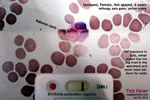Deaths of pets are part of my veterinary work since I graduated in 1974. Yet, after almost 50 years in practice, I feel much sadness in the death of this beautiful snow-white big dog that died 4 hours after arrival in my Surgery yesterday, despite treatment and fluid therapy. She was middle-aged and quite plump, as cuddly as a miniature polar bear. Not a brown stain on her white coat. No skin disease unlike some others.
 I had taken a blood sample and did the tick-fever test
for Babesia and Ehrlichia. The cause of death was
babesiosis (identified as Babesia canis by blood
smear), known as tick fever. The Ehrlichia test was
negative. I handed the print-out (left) to the owner.
I had taken a blood sample and did the tick-fever test
for Babesia and Ehrlichia. The cause of death was
babesiosis (identified as Babesia canis by blood
smear), known as tick fever. The Ehrlichia test was
negative. I handed the print-out (left) to the owner."Would she have lived if Vet 1 had diagnosed her with tick fever 8 days ago?" the lady in her 40s had been referred by her brother to consult me thinking that her dog had liver failure and no chance to live.
I had told her that liver diseases are not a death sentence but it may be cured if the liver is infected, depending on the type of infections and degree of liver damage. Vet 1 had given her many liver supplements and doxycycline twice a day for 14 days. So she presumed her dog had liver disease and had no hope since the dog became extremely lethargic 8 days after consulting Vet 1.
"It is hard to say whether your dog would have lived if she was diagnosed as having tick fever instead of liver disease 8 days ago," I replied. Babesiosis is a direct and an immune-mediated haemolytic anaemia. The immune response is said to be more lethal than the parasites (merozoites or piroplasm) inside the red blood cells.
"Why didn't you consult Vet 1 if your dog is not well after 2 days of medication?"
"Vet 1 did not tell me to do that," she replied. "He gave me 14 days of the green tablets (doxycycline 100 mg/tablet), to give two tablets two times a day and other medicine. But my dog stops eating and drinks little yesterday. She was unable to stand up. She vomited brown stuff and passed black stools and brown urine. So, my brother asked me to consult you as he had been to your surgery before."
"The antibiotic you gave is ineffective against babesiosis," I said. "Your dog needed the anti-tick fever injection and supportive treatments."
"Why didn't Vet 1 diagnose tick fever?" she asked.
"In his case sheet faxed to me, he did write 3 diseases. They are pyometra, tick fever and liver failure."
"Why didn't he treat for tick fever?" she asked.
"He has written that you did not want the tick fever test to be done. So, it is your decision."
"Why didn't he tell me that I should do the tick fever test? Why did he ask me to take the antibiotics for 14 days first?"
"He did advise you about the test and had written down in his case sheet that you did not want the test done," I said. "It is up to the owner to decide as the owner pays for the test."
"Then why he did the blood test and the blood smear for? The ultrasound too."
"He did the blood test to screen the health of your dog esp. the liver and kidney functions. Your dog had been sick for one week before you saw him. The total white cell count was high. The platelets, red blood cells and haemogloin were lower than normal.
"But the values were not excessively high," the lady said to me. "So, there was not a big worry."
I noted that Vet 1 had written "refractile inclusion bodies seen in the red blood cells." This seemed to give a clue that it was possible that the red blood cells had Babesia parasites. However, a blood smear with the stains would reveal the parasites. According to Dr Daniel, the blood smear under Gram stain showed lots of red blood cells with Babesia inside.
But the owner had not wanted the "tick-vector test" and so the dog went home with liver medication, anti-abdominal fluid swelling (ultrasound had detected abundant fluid which was sucked out and examined by Vet 1) and vitamins.
"My dog could hop into the car when I brought her to see Vet 1," the lady said. "Now she just lay on her chest and refused to stand up."
"What is her normal sleeping position?" I asked.
"Belly up, like people," she said. "She would clean the Chow Chow's eye discharge every day but now does not do it."
Eight days had passed. My blood test showed kidney failure, elevated liver enzymes, a very high total white cell count of 46 as compared to 20 when tested by Vet 1. The normal range is 5-17. The platelets were 26 as compared to 166 earlier (200 - 500). Red blood cells were much lower.
"What are the purplish spots on her belly?" the owner asked me when she came to see the dog at 9 pm yesterday. The dog had passed away at around 7 pm. "Those are areas of skin bleeding as the platelets are very low," I said. "Your dog had difficulty breathing and vomited blood before she passed away peacefully."
The dog first showed lethargy 15 days ago. The owner said that the dog had never gone downstairs and had never got any ticks for the past 6 years. Since this dog was so well groomed and never went downstairs, I could believe her that the dog had no exposure to ticks.
"Did the dog go to the groomer?" I asked.
"Yes, 2 months ago," she said. "I brought her to a new groomer. But she had no ticks on her body when she came back from the groomer."
"Why didn't you go to the old groomer?" I asked.
"He has stopped grooming since his groomer left."
"It is a strange case as a dog must be bitten by an infected tick to get tick fever. Since you were so sure that your dog never had ticks, Vet 1 might have ruled out a high possibility of tick fever infection and went for liver failure diagnosis."
CONCLUSION
In many cases, owners do not want laboratory tests. However, the vet must be forceful in warning the owner of the fatal consequences of tick fever if the dog is not treated early. Refractile inclusion bodies in the red blood cells were the clue as blood parasites like Babesia can cause refractile inclusion bodies to be formed.
It might be wise to treat as if the dog had tick fever rather than following the protocol of confirming tick fever, if economic reasons prevail. The interest of the dog is paramount and if the owner cannot afford the test, it may be advisable to strongly advise it being done.
 Did the vet phoned the owner 3 days after
consultation? I believe he had done so and he had
recorded in the case file. However, he wanted to speak
to the owner on the day he faxed the medical records
to me as the owner was with me. He told the owner that
he had tried to phone her 3 days after consultation,
but her phone was not responding.
Did the vet phoned the owner 3 days after
consultation? I believe he had done so and he had
recorded in the case file. However, he wanted to speak
to the owner on the day he faxed the medical records
to me as the owner was with me. He told the owner that
he had tried to phone her 3 days after consultation,
but her phone was not responding. "He could have added this record in after I asked for the medical report," the lady owner had a very difficult time getting the report to be released to me and therefore had her suspicions.
What was the cause of death in this dog? Only an autopsy would find the answer but the owner would not want one. The dog was sent for cremation by her relative. As to the possible cause of death, one experienced vet said it was kidney failure rather than liver failure, Dr Daniel told me. As for me, I would say that the immune-mediated haemolytic anaemia reactions of Babesia canis was the primary cause of the dog's quick death rather than the destruction of the red blood cells. Kidney and liver failures were the consequences.
My hypothesis is that the reaction caused platelets to be extremely low and the dog would bleed internally to death. In the evening when the owner came, she pointed to several bruised like spots on the shaved abdomen where the first vet had done his "abdominal tap" to take out the peritoneal fluid. "These are bleeding spots caused by the tick fever parasite reactions," I said to the wife. The dog had coughed up some blood before dying.
It was one of those unusual cases as the dog was said not to have been exposed to any ticks over the past years as she lived in the apartment and never went done for walks. If there was definitely no exposure to ticks, the first vet was distracted and went for liver failure diagnosis, disregarding the clue of the presence of refractile inclusion bodies in the red blood cells.
Singapore pet owners are getting more sophisticated and demanding and therefore, evidence-based medicine and defensive medicine must be practised nowadays. All advices and client's objections to tests and advices must be recorded properly in the case file as a good habit. In this case, medical negligence would not stand in court, I believe, as the vet did advise an anti-tick vector test and the owner had been informed and had objected to it. The burden of proof is on the owner when negligence is alleged and the proof was not there in this case.

 Toa
Payoh Vets
Toa
Payoh Vets